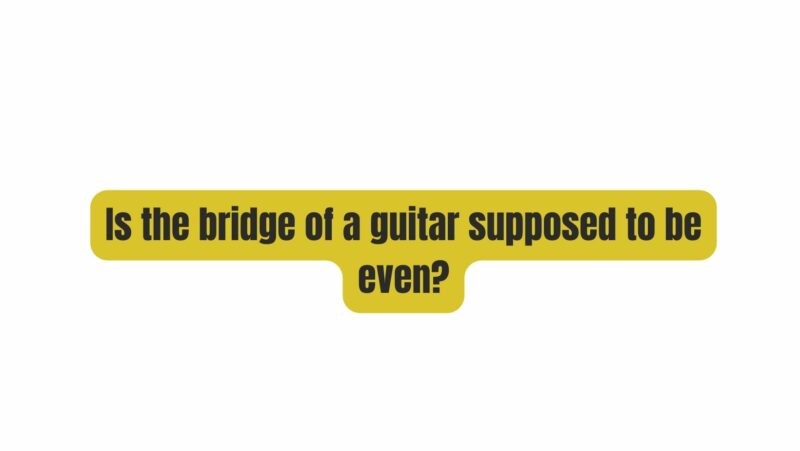Guitars, be they acoustic or electric, are not only instruments of melody and rhythm but also intricate works of art. One component of a guitar that often garners attention and debate among musicians and enthusiasts is the bridge. Specifically, the question arises: Is the bridge of a guitar supposed to be even? In this comprehensive article, we will explore the significance of an even bridge, the reasons it may or may not be perfectly even, and how it impacts the instrument’s playability and sound.
The Guitar Bridge: An Integral Component
Before we delve into the debate over an even guitar bridge, let’s establish the critical role that the bridge plays in the guitar’s overall functionality. The bridge serves several key functions:
- String Anchoring: The bridge acts as an anchor point for the guitar strings, maintaining tension and ensuring tuning stability.
- Sound Transmission: It is in direct contact with the guitar’s soundboard (top), transferring the vibrations of the strings to the body of the guitar, ultimately shaping the instrument’s tonal character.
- Intonation Adjustment: Bridge saddles can be adjusted to fine-tune the intonation of each string, ensuring that notes play in tune at various positions along the neck.
The Controversy of an Even Guitar Bridge: An Exploration
Now, let’s dive into the debate surrounding the evenness of a guitar bridge and dissect the factors that come into play:
- Ideal Aesthetic Symmetry: From an aesthetic standpoint, many guitarists and guitar enthusiasts prefer the bridge to be even, meaning that the saddle, where the strings make contact, is parallel to the nut at the headstock. An even bridge is visually pleasing and imparts a sense of balance and symmetry to the instrument.
- Functional Considerations: While evenness is desirable from an aesthetic perspective, it’s not always the top priority for functional reasons. Guitars are crafted with a specific purpose in mind, whether it’s for strumming chords, fingerstyle playing, or intricate solos. Depending on the playing style and desired sound, the bridge may be set up to optimize playability and intonation rather than visual symmetry.
Playability vs. Aesthetics: The Great Bridge Dilemma
The tension between playability and aesthetics is at the heart of the debate over an even guitar bridge:
- Playability Emphasis: For many guitarists, especially those who focus on lead playing and complex fretwork, playability takes precedence. In such cases, the bridge may be intentionally adjusted to achieve optimal string action (the height of the strings above the fretboard) and intonation. This adjustment might result in a bridge that appears slightly tilted, deviating from visual evenness.
- Aesthetic Appeal: On the other hand, some players prioritize the visual appeal of their instruments. A perfectly even bridge aligns with the notion of a well-crafted and visually harmonious guitar. However, achieving this evenness without compromising playability and intonation can be a delicate balance.
The Science of Intonation: A Critical Factor
Intonation, the accuracy of a guitar’s tuning across the fretboard, plays a crucial role in the debate over evenness:
- String Length and Intonation: Intonation is influenced by the length of the vibrating portion of each string. To ensure that open and fretted notes are in tune with each other, the saddle’s position on the bridge may need to be adjusted. This adjustment can result in a bridge that is not perfectly even.
- Harmonics and Overtones: When a string is fretted, it produces not only its fundamental pitch but also a series of harmonics and overtones. These additional frequencies can affect the perceived pitch of a note. Adjusting the saddle position to account for these harmonics is crucial for achieving accurate intonation, even if it means deviating from visual evenness.
Customization and Personal Preference
It’s important to recognize that the ideal bridge setup can vary from one guitarist to another based on personal preference, playing style, and musical genre. Customization is key, and many accomplished luthiers and technicians work closely with players to achieve a bridge setup that balances playability, intonation, and aesthetics.
Conclusion: The Harmony of Sound and Vision
In conclusion, the debate over whether the bridge of a guitar should be even or not is a complex one that involves a delicate balance between aesthetics and functionality. While many players appreciate the visual appeal of an even bridge, it’s essential to recognize that the ultimate goal is to create an instrument that sounds and plays beautifully.
An even bridge can be aesthetically pleasing, but it’s not always the best choice for every playing style or musical genre. The science of intonation and the pursuit of optimal playability often lead to bridge setups that may not conform to perfect evenness.
Ultimately, the harmony of sound and vision should guide the decision-making process. Whether your bridge is perfectly even or adjusted for optimal performance, what matters most is the music you create with your instrument and the joy it brings to your musical journey.


